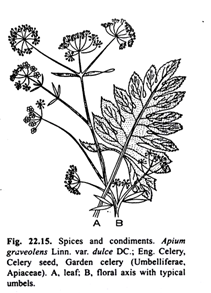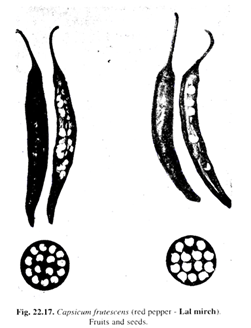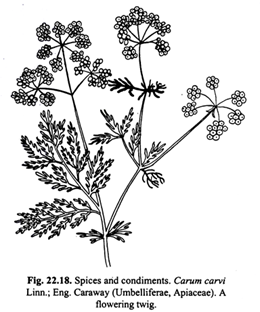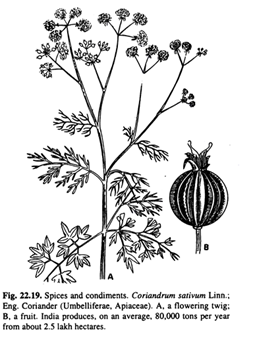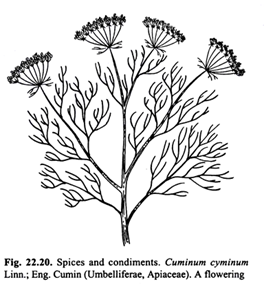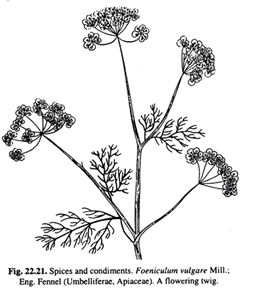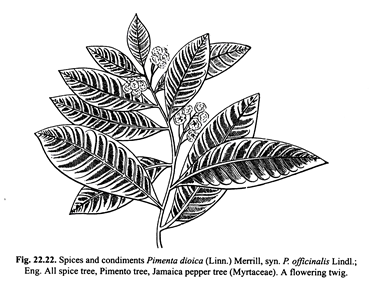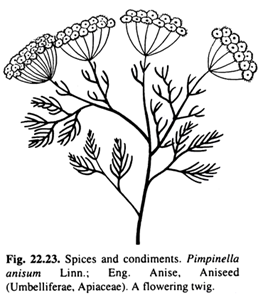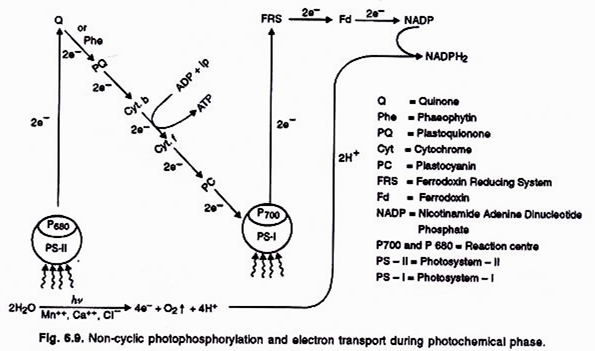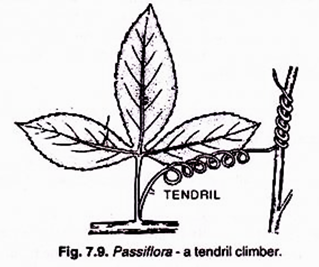The following points highlight the top thirteen spices obtained from fruits. The spices are: 1. Celery 2. Sweet Pepper 3. Red Pepper, Chillies 4. Caraway 5. Coriander 6. Cumin 7. Fennel 8. Allspice 9. Anise 10. Indian Long Pepper 11. Black Pepper 12. Ammi 13. Vanilla.
Spice # 1. Celery:
Apium graveolens Linn. var. dulce DC.; English—Celery, celery seed, garden celery; Hindi—Ajmud, bari-ajmud, karafs; Bengali— Chanu, randhunv, Mumbai—Bori ajamoda, ajmud; Punjabi—Bhut jhata; Arabic—Karafs; Persian— Karasb; Family—Umbelliferae (Apiaceae).
It is native of England and other parts of Europe. In India, it is cultivated in the Northwestern Himalayas and in the hills of Uttar Pradesh, the Punjab and South India. In Indian plains, it is cultivated during the cold weather, chiefly as a garden crop in the vicinity of towns. The fruits are small and dark brown with peculiar flavour.
Uses:
The herb is eaten as salad, or made into soup. The seed (fruit) is eaten as spice. The seed tied into a piece of cloth are used to flavour soup. The soil extracted from the seeds is stimulant and used chiefly for flavouring soups and curries. The seeds are also cordial, tonic, carminative, diuretic, emmenagogue and antiseptic.
Chemical Composition:
Moisture 5.1%; protein 18.1%; fat (ether extract) 22.8%; crude fibre 2.9%; carbohydrates 40.9%; total ash 10.2%; calcium 1.8%; phosphorus 0.55%; iron 0.45%; sodium 0.17%; potassium 1.4%; iron 0.53%; vitamin B1, (thiamine) 0.41 mg/100 g.; vitamin B2 (riboflavin) 0.49 mg/100 g.; vitamin C (ascorbic acid) 17.2 mg/100 g.; niacin 4.4 mg/100 g.; vitamin A 650 international unit (I.U.); calorific value 450 calories/100 g.
Spice # 2. Sweet Pepper:
Capsicum annuum Linn.; English— Sweet pepper, paprika, Hungarian paprika, Spanish pimento; Family—Solanaceae.
This is a non-pungent variety of chilli. The red paprikas are famous for their brilliant red colour and mild flavour. Several varieties of paprika have been successfully grown at the IARI, New Delhi and Central Food Technology Research Institute (CFTRI), Mysore. Since several varieties of Capsicum annuum Linn, are used to produce paprika, pods in one growing area may differ in shape and appearance of those from another.
Some pods are round in shape with pointed end whereas, the others are elongated. They are medium to small and quite fleshy. They are produced on small, bushy plants. When ripe, the pods are picked and dried in the sun. It is processed into powder where it is grown. The paprika pods are supposed to be one of the richest sources of ascorbic acid (vitamin C).
Uses:
Paprika is used for its colouring and flavouring properties. It is used largely as a garnish for light coloured foods, such as eggs, fish, potatoes, salads and salad dressings. In food manufacturing, flavour is important, as this spice becomes a vital ingredient of sausages, soups, salad, salad dressings and many ready prepared foods.
Chemical Composition:
Moisture 7.9%; protein 13.8%; fat 10.4%; fibre 19.2%; carbohydrates 41.1%; total ash 7.6%; calcium 0.2%; phosphorus 0.3%; iron 0.23%; sodium 0.02%; potassium 2.4%; vitamin B, (thiamine) 0.60 mg/100 g.; vitamin B^ (riboflavin) 1.36 mg/100 g.; vitamin C (ascorbic acid) 58.8 mg/100 g.; niacin 15.3 mg/100 g.; vitamin A 4915 International Units (I.U.)/100 g.; calorific value 390 calories/100 g.
Spice # 3. Red Pepper, Chillies:
Capsicum frutescens Linn.; Syn. C. annuum Linn.; English—Red pepper; chillies; Hindi & Punjabi—Lai mirch, marcha, mirch, gachmirch, mattisa, wangru, Bengali—Lal-mirch, lanka- marich, gach-marich; Kumaon—Matisa-wangru; Kashmiri—Mirtz-a-vangun, mirch-wangum: Gujarati—Lal-mirch, marchu, Marathi—Mirsinga; Tamil—Milagay, mollagu; Telugu— Mirapakaya; Malayalam—Kappal-melaka; Kannada—Mena-sina-kayi; Sanskrit—Marichi- phalam; Persian—Filfile-surkh, pilpile-surkh; Family—Solanaceae.
It is native of the West Indies and tropical America, most probably of Brazil. Commonly cultivated for its fruit throughout the plains of India, and on the lower hills such as Kashmir, and in the Chenab valley upto altitude 6,500 feet. When grown on the hills it is said to be very pungent.
There are several varieties, differing chiefly in the length, shape, and colour of the fruit, some being round, others oblong, obtuse, pointed or bifid, smooth or rugose, and red, white, yellow or variegated. The very pungent principles are present in the flesh and rind as well as seeds. The ripe fruits are dried in the sun and used whole or powdered.
It is a herb, 2 or 3 feet in height, with entire ovate leaves, white flowers with a rotate corolla, and many-seeded fruits, which are technically berries.
Cultivation:
Chillies can be cultivated as a field crop over a wide range of tropical and sub-tropical conditions. It grows well up to an altitude of 5,000 feet a.s.1., in tracts receiving an annual rainfall of about 25 to 50 inches. Heavy rains during the growing period lead to rotting of leaves and fruits.
The crop can be grown both in the rainy season commencing from about June and in the hot weather about February. In areas of heavy rainfall the crop is taken after the monsoon period. In tracts of low rainfall, the crop is grown under irrigation.
The soils best suited for the cultivation are of the heavy loam type, from grit, gravel, and stones and well drained.
The seed is sown in the end of June or in the beginning of July in well prepared nursery beds. When the seedlings are about 40-45 days old, they are transplanted. At the nursery stage frequent irrigation is required.
The flowering of the plants begin after about a month of transplanting. In another one month, the first crop of green chillies is ready for picking. From about the month of November the fruits begin to ripen and change in colour, first to a deep orange and then to red.
The fruits are gathered as they become red. About the middle of December the picking is in full swing. The plants continue to bear the fruit to the end of February. After being gathered, the fruits are dried in the sun. If the colour is not fully developed, they are heaped up until the colour develops fully, and then dried in the sun.
They are usually trampled lightly when they are drying, so that they may be flattened and their packing in bags for storage and transport may become easy. Process of drying usually takes about a fortnight. Well irrigated crops yield 1,500 lb. to 2,500 lb. per acre.
Uses:
The fruit when green is used for pickling and when ripe is mixed with tomatoes to make sauces. It is also dried and ground for use. The consumption of chillies is very great, and both rich and poor daily use them.
The chillies form the principal ingredient in all chutneys and curries. They are ground into a paste, between two stones (Silbatta), with a little mustard oil, ginger and salt, they form the only seasoning which the millions of poor can obtain to eat with rice.
Spice # 4. Caraway:
Carum carvi Linn.; English— Caraway; Hindi—Shiajira, zira; Bengali—Jira; Punjabi—Zira siyah; Kashmiri—Gunyun; Ladakh—Unbu; Tamigu—Shimai-shombu; Telugu—Shimai- sapu, Sanskrit—Sushavi; Persian— Karoya; Family—Umbelliferae (Apiaceae).
A herb; native of Europe and West Asia, now cultivated in Bihar, Orissa, the Punjab, Bengal and Andhra Pradesh, as a cold season crop. It is frequently cultivated on the hills, as a summer crop in Kashmir and Garhwal at an altitude of between 9,000 and 12,000 feet. It is a perennial with thick roots, compound leaves with linear segments and small white flowers.
The fruits are brown in colour, slightly curved and tapering. The spice seems to have come into use in Europe about the thirteenth century, and it was known in England at the close of the fourteenth century.
Uses:
The fruit (seed) is used parched and powdered, or raw and entire. In the former case it is employed to flavour curries; in the latter it is put in cakes. It is used in confectionery and in flavouring drinks. It also produces a spirit cordial. It is carminative and largely used in curry powder.
A valuable essential oil is obtained from the “seeds” called caraway oil. The oil is a mixture of a hydrocarbon (carvene) and an oxygenated oil, C10H14O (carvol). The oil possesses a strong odour and flavour of the fruit. It is used medicinally and to flavour curries.
Chemical composition of fruit of Carum carvi Linn. Moisture 4.5%; protein 7.6%; fat 8.8%; fibre 25.2%; carbohydrates 50.2%; total ash 3.7%; calcium 1.0%; phosphorus 0.11%; sodium 0.02%; potassium 1.9%; iron 0.09%; vitamin B1 (thiamine) 0.38 mg/100 g.; vitamin B2 (riboflavin) 0.38 mg/100 g.; vitamin C (ascorbic acid) 12.0 mg/100 g.; niacin 8.1 mg/100 g.; vitamin A 580 International Units (I.U.); calorific value 465 calories/100 g. of spice.
Spice # 5. Coriander:
Coriandrum sativum Linn.; English—Coriander; Hindi—Dhaniyai Bengali—Dhane; Sanskrit—Dhanyaka-, Tamil—Kotamallv, Telugu—Danyalu, kotimiri; Kannada—Kotambari; Nepali—Danya; Persian—Kushniz; Family—Umbelliferae (Apiaceae).
It is a native of the Mediterranean region. It is grown extensively in India, Russia, Central Europe, Asia Minor and Morocco. In India, it is cultivated in all the States. The more important States for its cultivation are – Andhra Pradesh, Assam, Maharashtra, Tamil Nadu, Uttar Pradesh, Karnataka, Himachai Pradesh and Madhya Pradesh.
The plant is generally 2-3 feet in height, with white or pinkish flowers. The lower leaves have broad segments, while the upper are very narrow. The fruits are small, oval and aromatic. Technically the fruit is known as “cremocarp”. Each fruit consists of two one-seeded carpels, or mericarps with numerous oil ducts (vittae).
Cultivation:
It is cultivated mostly as rain-fed crop, either pure or mixed with other crops. It is also grown as an irrigated crop in some areas. The sowing time differs in different parts of India. In Northern India, the seeds are sown during winter; in Maharashtra during rainy season; in Tamil Nadu during autumn and in Karnataka and some parts of Tamil Nadu from May to August and from October to January.
The seed germinates in 10-25 days after sowing. Two or three weeding’s are necessary for the crop. Irrigation is done when it is needed. Proper manuring increases the yield. The crop is ready in three to three and half months after sowing.
The plants are pulled out along with the roots and dried. Therefore, the fruits are threshed out, further dried in the sun, winnowed and stored. The yields vary from place to place. It ranges from 300 kg. to 900 kg. per acre.
Uses:
The fruits and leaves are aromatic and used as flavouring materials. The fruits are used extensively in the preparation of curry powder, pickles, sauces, soups, sausages and seasonings. They are also employed for flavouring pastries, cookies, buns and cakes and tobacco products. It is also used for flavouring liqueurs, particularly gin.
The fruits are used both as spice and condiment. It is an important condiment used widely in all parts of India. A major part of the produce is used within the country.
The fruits are also used as stimulant, carminative, stomachic, diuretic, antibilous, refrigerant, aphrodisiac and tonic. Oil of Coriander is used in medicine and for flavouring beverages. The Coriander leaves make one of the richest sources of vitamin C (i.e., 250 mg/100 g.) and vitamin A (i.e., 5200 I.U./100 g.).
Spice # 6. Cumin:
Cuminum cyminum Linn.; English—Cumin; Hindi—Zira; Bengali—Jira, Gujarati—Jiru, jira-utmi-, Marathi—Jire; Tamil—Shirangam-, Ttlugu—Jiraka, Jilakarra-, Kannada—Jiringe, jirage-, Malayalam—Jirakam; Sanskrit—Jiraka, jirana; Persian—Zira-, Arabic—Kamun; Family—Umbelliferae (Apiaceae).
It is native of Mediterranean region. In India, it is cultivated mainly in the Punjab, Rajasthan, Haryana and Uttar Pradesh. The plant is a little annual herb with small pinkish flowers. The elongated oval fruits are aromatic and light brown in colour.
Cumin is a very old spice. It would appear to have been known to the ancients; at least there are names for it in most of the classical languages. During middle age it was one of the most favoured of spices. It was in frequent use, for example, in England in the thirteenth century.
Uses:
The aromatic fruits are used as spice and condiment. The fruits are used in soup, curries, cake, bread, cheese and pickles. They form an ingredient of some curry powders and pickles.
The fruit contains an essential oil, which is a mixture of cymol and cuminol and other hydrocarbons. Both fruit and oil possess carminative properties. They are also aromatic, stimulant, stomachic and astringent. Their warm bitterish taste and aromatic odour reside in the volatile oil.
Chemical Composition:
Moisture 6.2%; protein 17.7%; fat 23.8%; crude fibre 9.1%; carbohydrates 35.5%; mineral matter 7.7%; calcium 0.9%; phosphorus 0.45%; sodium 0.16%; potassium 2.1%; iron 0.048%; vitamin B1 (thiamine) 0.73 mg/100 g; vitamin B2 (riboflavin) 0.38 mg/100 g; vitamin C (ascorbic acid) 17.2 mg/100 g; niacin 2.5 mg/100 g; vitamin A 175 International Units (I.U.); calorific value 460 calories/100 g.
Spice # 7. Fennel:
Foeniculum vulgare Mill.; English—Fennel; Hindi—Saunf; Bengali—Mauri, pan-muhori; Mumbai—Bari-shopha, panmohuri; Gujarati—variari, Variyali; Marathi—Badishep; Kannada— Badisopu; Tamil—Sohikira; Telugu—Pedda-jila-kurra’, Sanskrit—Madhurika; Family— Umbelliferae (Apiaceae).
It is a stout, glabrous, aromatic herb, 5-6 feet high; leaves pinnately decompound; flowers small, yellow, in compound terminal umbels; fruit oblong, ellipsoid or cylindrical, 6-7 mm. in length, straight or slightly curved, greenish or yellowish brown; mericarp 5-ridged with prominent vittae.
Fennel is a very old flavouring substance. It was known to the ancient Hindus, Chinese and Egyptians as a culinary spice. It is native of Mediterranean region. In India, it is cultivated mainly in the Punjab, Uttar Pradesh, Assam, Maharashtra and Baroda.
It is cultivated mostly as a garden or homeyard crop throughout India at all altitudes upto 6,000 feet. It requires a fairly mild climate and is cultivated as a cold weather crop in parts of Northern India.
Cultivation:
It grows well in any good soil, but thrives best in rich, well-drained loam or black sandy soil containing sufficient lime. It is propagated mainly by seeds. Seeds are sown broadcast by hand or by shallow drills.
The time of sowing is October-November in the plains of India and March-April on the hills. When 3-4 inches high, the plants are thinned out to about 1 feet apart. Occasional weeding and irrigation once a week during dry weather is being done.
Harvesting:
The crop is harvested before the fruits are fully ripe. The stems are cut with a sickle and spread out to dry in the sun. When dry (4-5 days after cutting) the fruits are threshed out and cleaned by winnowing. The yield ranges from 2800 to 1120 lb. per acre.
Uses:
The leaves are used in fish sauce and for garnishing. Leaf stalks are used in salad. The leaf stalks are also used as vegetable. The leaves also possess diuretic properties. The roots are used as purgative and they possess an aromatic odour and taste.
Dried fruits of fennel have a fragrant odour and a pleasant aromatic taste. They are used for flavouring curries, soups, meat dishes, sauces, bread rolls, pastries and confectionery. They are also used for flavouring liqueurs and in the manufacturing of pickles.
The fruits are aromatic, stimulant and carminative. They are useful in the diseases of chest, spleen and kidney. It is used as one of the condiments in liquorice powder. A hot infusion of the fruits is used to increase lacteal secretion and to stimulate sweating. Fennel fruits from Lucknow are considered to be the best and are priced higher than those from other areas.
Fennel Oil:
The fruit of fennel also contains a volatile oil. The oil is obtained by steam distillation of crushed fruits. It is a colourless or pale yellow liquid with a characteristic taste and odour. The main constituent of the fennel oil is anethole. Oil of good quality contains 50-60% anethole.
Fennel oil is largely used as a flavouring agent in culinary preparations, confectionery, cordials and liqueurs. It is a good aromatic and widely carminative. It is used in colic and flatulence of infants. It makes a good vermicide against hookworm. It is used in the preparation of fennel water. It is used in perfumery and in scenting soaps.
Chemical Composition:
Moisture 6.3%; protein 9.5%; fat 1.0%; crude fibre 18.5%; carbohydrates 42.3%; mineral matter 13.4%; calcium 1.3%; phosphorus 0.48%; sodium 0.09%; potassium 1.7%; iron 0.01%; vitamin B1 (thiamine) 0.41 mg/100 g.; vitamin B2 (riboflavin) 0.36 mg/100 g; vitamin C (ascorbic acid) 12.0 mg/100 g; niacin 6.0 mg/100 g.; vitamin A 1040 International Units (I.U.); calorific value 370 calories/100 g.
Spice # 8. Allspice:
Pimenta dioica (Linn) Merrill syn. P. officinalis Lindl.; English—Allspice tree, Jamaica Pepper tree; Family—Myrtaceae.
It is a bushy evergreen tree, 6-9 m. high. It is native of West Indies and tropical America. It is grown in gardens in India. Leaves oblong-lanceolate, coriaceous; flowers white, in terminal and axillary trichotomous paniculate cymes; fruit a globose berry, about the size of a pea seed, black or purple, two seeded; seeds deep brown, reniform.
The unripe berries, when rapidly dried, form the Allspice, Jamaica Pepper or Pimento of commerce. In India, the plant is cultivated in gardens, especially in Bengal, Bihar, Orissa and Mysore. It grows well in Mysore and fruits heavily. The plants are propagated by seeds. Seeds are sown under shade in freshly prepared beds or in pots.
The beds should be well watered before sowing, and the seeds should be thinly broadcast and lightly covered with coir waste. Seedlings are potted in large containers at the 2- and 4- leaf stage and are ready for planting in the field when they are 25-35 cm. in height. The tree begins fruiting when about seven years old and continues so upto twenty years. The berries are picked when mature, but still green.
The berries are quickly dried in the sun for 4-10 days; They become wrinkled like black pepper and turn reddish brown in colour and the aroma becomes more pronounced. Average yield of a tree is about 35-45 kg. of berries. Dried berries are nearly globular, 4-7 mm. in diameter, reddish brown and with a wrinkled surface.
The berries possess an aromatic taste and flavour resembling a mixture of cinnamon, cloves and nutmeg, and hence the name Allspice. Allspice owes its characteristic odour to the presence of an essential oil (3.3-4.5%), found mainly in the pericarp. Allspice is available whole or ground.
Uses:
The berries are used as a condiment, as a flavouring agent in sauces, soups, pickles, canned meats, sausages, etc.. It is an important ingredient of whole mixed pickling spice, and spice mixtures, viz., curry powders, mincemeat spice, poultry dressing, pastry spice, etc. They are used for flavouring liqueurs. Pimenta berry oil is used for flavouring condiments and food products. The oil is used also as a carminative and stimulant.
Chemical composition of ground berries. Moisture 8.8%; protein 6.0%; fat 6.6%; fibre 21.6%; carbohydrates 52.8%; total ash 4.2%; calcium 0.8%; potassium 1.1%; iron 7.5%; vitamin B1, (thiamine) 0.1 mg/100 g; vitamin B2 (riboflavin) 0.06 mg/100 g; vitamin C (ascorbic acid) 39.2 mg/ 100 g; niacin 2.9 mg/100 g; vitamin A 1445 International Units (I.U.); calorific value 380 calories/ 100 g.
Spice # 9. Anise:
Pimpinella anisum Linn.; English—Aniseed, Hindi—Saunf, badian; Bengali—Muhuri, mitha- jira; Marathi—Somp; Gujarati—Anisa; Telugu—Kuppi-, Tamil—Shombu, Kannada— Shombu; Oriya—Sop; Family—Umbeiliferae (Apiaceae).
It is native of the Eastern Mediterranean region. It is widely cultivated in Europe, Russia, North Africa, Mexico and South America. In India, it is grown to a small extent. It is grown in Uttar Pradesh, the Punjab and Orissa. It is stated that a commodity commonly available in Indian market under the name Lucknow saunf is called Indian Aniseed.
The plant is an annual about 2 feet in height with simple based leaves and pinnately dissected steam leaves. The small fruits are greyish brown and covered with short hairs.
The plant is well grown in light, fertile or moderately rich, well drained sandy loam. It is propagated by seeds. Seeds are sown broadcast or in drills, 20-40 cm apart. It is commonly sown from the middle of October to the end of November in the plains, and from the beginning of April to the end of May on hills. When the seedlings are 5-8 cm. in height, they are thinned to stand 10- 15 cm. apart in a row.
The plants require, occasional weeding and watering once a week. The crop is ready to harvest in three and half months after planting when the fruits turn greyish green. The plants are tied in bundles and then stacked with the fruiting heads towards the centre. Fruits ripen in 4-5 days and are then threshed out, cleaned and bagged for the market. A yield of 445-665 kg. of fruit per hectare is expected.
Aniseed on steam distillation yields an essential oil, known as oil of anise, anise oil is a colourless or pale yellow liquid having the characteristic odour and taste of the fruit.
Uses:
The fruits are used as condiment. Now, oil of anise replaces the fruits for medicinal and flavouring purposes. Aniseed possesses a sweet aromatic taste and emits when crushed, a characteristic agreeable odour and is used for flavouring food, confectionery, bakery products, beverages and other liqueurs. The fruits are expectorant, stimulating, carminative, diuretic and diaphoretic.
Fresh leaves of the plant are used as a garnish and for flavouring salads.
Chemical Composition of Fruits:
Moisture 9-13%; protein 18%; fatty oil 8-23%; essential oil 2-7%; sugars 3-5%; starch 5%; nitrogen free extract 22-28%; fibre i2-25%; ash 6-10%; choline is also present.
Spice # 10. Indian Long Pepper:
Piper Longum Linn.; English—India long pepper; Hindi—Pipal, pipulmul, pipli, gaz pipai, Bengali—Pipul, pipli; Nepali—Popal pipai, Punjabi—Pipal, pipla mui, Mumbui—Pipli, pipla mui, Marathi—Pimpli; Gujarati—Pipli, piper, Tamil—Tippili, pipili, pippallw, Telugu—Pipili, pippali katte; Kannada—Yippalv, Malayalam—Lada, mulagw, Sanskrit—Pippali, upukulya, videhi, ushuna; Persian—Pilpil, filfil-i-daraz; Family—Piperaceae.
It is a native of India, Sri Lanka and Philippines Islands. It is a slender aromatic climber with perennial woody roots occurring in the hotter parts of India, from central Himalayas to Assam, Khasi and Mikir hills, lower hills of Bengal and evergreen forests of Western Ghats from Konkan to Travancore.
Cultivation:
It is cultivated on a large scale in limestone soil, 450 to 600 m. below the Cherrapunji region. It is cultivated mainly by layering of mature branches or by suckers. The plants flower in August and September, and the fruits mature in January. The spikes are harvested in January, while still green and unripe, as they are most pungent at this stage.
They are dried in the sun when they turn grey. The yield increases from 560 kg. per hectare in the first year to 1,680 kg. per hectare in the third. After third year the vines become less productive and should be replaced.
India imports ‘a large’ quantity of long pepper from Malaysia and Singapore.
Uses:
The fruits are used as spices and also in pickles and preserves. They have a pungent pepper-like taste and produce salivation of the mouth. Long pepper, though considered inferior to black pepper, is considerably used as spice.
The dried unripe fruit and the root have long been used in medicine. They are considered heating, stimulant, carminative, alterative, laxative, and useful in cough, hoarseness, asthma, dyspepsia and paralysis.
The work on the fruit of Piper longum has shown the presence of the alkaloids—piperine and piplartine.
Spice # 11. Black Pepper:
Piper nigrum Linn.; English—Black pepper; Hindi—Kalimirch, golmirch, choca mirch; Bengali—Kalamorich, golmorich; Marathi—Kalimirch, mire; Gujarati—Kalamari, kalomirich; Tamil—Milagu; Telugu—Miriyala tige; Kannada—Kare menasu; Malayalam—Kurumulaku, nallamulaku; Punjabi—Golmirich; Kashmiri—Martz; Sanskrit—Maricha, ushana, hapusha; Family—Piperaceae.
A branching, climbing perennial shrub, mostly found cultivated in the hot and moist parts of India, Ceylon and other tropical countries.
Branches stout, trailing and rooting at the nodes; leaves entire. 12.5-17.5 by 5.0-12.5 cm., very variable in breadth, sometimes glaucous beneath, base acute rounded or cordate, equal or unequal; flowers minute in spikes, usually dioecious; fruiting spikes very variable in length and robustness, rachis glabrous; fruits ovoid or globose, bright red when ripe; seeds usually globose, testa thin, albumin hard.
Pepper is one of the most ancient crops cultivated in India and has probably originated in the hills of south-western India, where it is met with in a wild state in the rain forests from North Kanara to Kanyakumari. The pepper vine in its wild state is mostly dioecious and consequently rarely sets fruit. Under cultivated condition, however, the fruiting is very much better, since most of the cultivated types are bisexual.
Almost all the types cultivated at present are selections from wild plants. Some crosses have already been evolved at the Pepper Research Station, Panniyur (Kerala). Of these, the hybrid, Panniyur I, a progeny from a cross between Taliparamba No. 1, noted for its high yield. Panniyur I is a good hardy climber and has long spikes with close set, large fruits.
Cultivation:
In India, pepper is cultivated mostly as a mixed crop in homestead gardens. Under this system, the vines are trained on to existing trees like jack, mango, coconut or arecanut. The vines receive intensive care and continue to be productive upto 60 or even 100 years. The vines are also grown as in inter – or subsidiary crop along with other plantation crops like coffee, cardamom, arecanut, coconut and orange.
This practice is more common in North Kanara, Coorg and parts of Kerala. As a pure crop, pepper is grown on a plantation scale only in small areas in the sub-montane tracts and lower altitudes in South Kanara, Malabar, Wynad and Travancore. India has been a leading producer and exporter of pepper. India, Indonesia, Ceylon, Cambodia and Sarawak, Brazil and Malagasy are main producers of pepper.
In India Kerala on the west coast produces nearly 95% of the total output. In India, pepper is grown mainly in Kerala, Tamil Nadu and Mysore and to a less extent in Assam.
Climate and Soil:
The pepper vine is found growing upto an altitude of 1,500 m., but thrives best at about 500 m. Pepper requires a warm and humid climate. It thrives in places where the annual rainfall is well over 200 cm. Pepper plants are pollinated by rain-water and consequently satisfactory yields are obtained when frequent showers of rain occur during blossoming period.
Pepper thrives best on virgin soil rich in humus and other plant nutrients. Naturally well drained, red laterite soils or alluvial soils rich in humus seem to be highly suitable for this crop. In Kerala, major part of the pepper cultivation is on laterite or sandy loam along the alluvial banks of the rivers.
Propagation:
The pepper vine can be propagated either vegetatively or by seeds. Vegetative propagation is universally adopted. However, it is believed that the plants raised from seeds live longer, and give heavier crops in later years than plants raised vegetatively.
There are two types of vegetative shoots preferred for planting, viz., the runners which are usually confined to the bottom portion of the vines, and the terminal shoots towards the top region. The runners form the most common material for propagation. In some areas, particularly in North Kanara, the terminal shoots of the top fruiting branches are preferred.
Plants raised from such cuttings are said to yield even in the second year of planting and produce a satisfactory crop from the fourth year onwards while vines raised from runner shoots give satisfactory yields only from the sixth or seventh year.
Planting:
The planting of the pepper vine is done either in July or August. The pits for planting are made preferably on the north and north-eastern sides of the standard so that the severe western sun is avoided.
Manuring:
Pepper is an exhausting crop and the soil needs high level of nitrogenous manuring,
Harvesting and yield. An adult vine yields annually 0.5 kg. dried fruits under Indian conditions. The yield goes on increasing as the vines get older upto about the tenth year. Usually there are two crops in a year. One in August-September and the other in March-April. When the fruits are ready for harvest, the whole spikes are removed from the vines with the aid of a ladder.
They are dried in the sun for 3-4 days, and the fruits separated from the stalks by beating the dried spikes with a stick or by trampling under foot. When completely dry, the outer skin of the fruits become black and wrinkled. It is estimated that 100 kg. of green pepper roughly yield 33 kg. of dried pepper.
In India, the average yield of commercial black pepper has been found to vary from 110 to 335 kg. per hectare.
Black Pepper:
Black pepper consists of the dried, fully developed unripe fruits. It is nearly globular in shape, about 4-5 mm in diameter with the characteristic coat with deep set wrinkles. The freshly harvested spikes are spread on cement floors or mats and dried in the sun for about a week. During drying the green or red fruits gradually change in colour to dark brown or almost black and their skin becomes tough and wrinkled.
The fruits are detached from the stalks by beating the heaped up material with sticks or treading upon it barefooted. The outturn of dried black pepper obtained from green fruits varies from 26-29% depending upon the type.
White Pepper:
It consists of dried ripe fruits, freed of their pericarp. In preparing white pepper the separation is done through the zone of fibro-vascular bundles, i.e., only a part of the mesocarp is removed.
In India, the production is limited to very small quantities, by some households in Kerala, for medicinal and domestic usage. For this purpose, the fully ripe fruits are rubbed with hand to remove the soft rind, and dried. The white fruits obtained are then washed and finally dried.
Uses:
Pepper fruits are used as spice or condiment. In Kerala, fresh green pepper is sometimes used for preparing pickles. Black and white pepper make the major condiments employed for seasoning freshly cooked and prepared foods. In U.S.A. and other European countries they are used mainly for preserving meat.
The whole fruits are added to pickles, certain types of sausages, etc., but the bulk of the product is generally ground before use. Black pepper is mostly used for its characteristic aroma and pungent taste. White pepper is less pungent.
The aromatic odour of pepper is due to a volatile oil, while the pungent taste is caused by an oleoresin. An alkaloid is also present. Pepper stimulates the flow of saliva and the gastric juices and has a cooling effect. In modern Indian medicine, it is much employed as an aromatic stimulant in cholera, weakness following fevers, coma, etc., as a stomachic in dyspepsia, as an antiperiodic in malarial fever.
Chemical composition of different type of black pepper (Piper nigrum Linn.) varies. Moisture 8.7-14.1%; total nitrogen 1.55-2.60%; nitrogen in non-volatile ether extract 2.70-4.22%; volatile ether extract 0.3-4.2%; non-volatile ether extract 3.9-11.5%; alcohol extract 4.4-12.0%; starch 28.0-49.0%; ash 3.6-5.7%; crude fibre 8.7-18.0%; crude piperine 2.8-9.0%; piperine 1.7- 7.4%; Alkaloid piperine makes the biting taste.
Spice # 12. Ammi:
Trachyspermum ummi (Linn.) Sprague; English—Ammi, Lovage; Hindi—Ajwain, ajowan; Bengali—Jowan, juvani, Gujarati—Ajamo; Marathi—Owa; Kashmiri—Jawind; Tamil—Aman, Oman; Telugu—Omami, omamu; Kannada—Omu, oma; Mumbai—Ajwan owa; Sanskrit— Yamani; Persian—Zinian; Family—Umbelliferae (Apiaceae).
This is an aromatic herb. Cultivated extensively in India for its fruits (seeds); from the Punjab and Bengal to the South Deccan. It is first mentioned in Europe as brought from Egypt about 1549 A.D.
Uses:
The fruits are used as spice. They yield an oil of distillation with water, which is used medicinally. The fruits (seeds) are much valued for their antispasmodic, stimulant, tonic and carminative properties. They are considered to combine the stimulant quality of capsicum or mustard with the bitter property of chiretta, and the antispasmodic virtues of asafoetida.
Spice # 13. Vanilla:
Vanilla planifolia Andr.; Syn. V. fragrans (Salibs) Ames; English—Vanilla; Family— Orchidaceae.
It is climbing vine with fleshy adventitious roots, large succulent leaves, and greenish-yellow flowers. The fruits are long, thin, pod like capsules, known as vanilla beans. It is a tropical species and thrives in hot climate with frequent rains. It is propagated by means of cuttings. It is native of tropical America. In India, it is cultivated in the Nilgiris, Wynad, Coorg and Mysore.
The flavour and aroma are not present in the pods until they have been cured. The unripe fruits are subjected to a sweating process. They are exposed to the sun in the morning and are then protected by blankets in the afternoon, while at night they are placed in airtight boxes. During curing process a glucoside is changed by enzyme action into a crystalline substance, vanillin, which possesses the characteristic odour.
Chemical Composition:
Moisture 25.85-30.93%; protein 2.56-4.87%; fatty oil 1.68-6.74%; volatile oil 0.0-0.64%; nitrogen free extract 30.35-32.90%; fibre 15.27-19.6%; carbohydrates 7.1-9.1%; ash 4.5-4.7%; vanilline 1.48-2.90%; resins 1.5-2.6%; calcium 19.7%; phosphorus 9.5%; sodium 6.7%; potassium 16.2%; iron 0.3%.
Uses:
The pods are used for flavouring confectionery and in perfumery. Vanilla is used in flavouring chocolate, ice creams, candy, beverages, cakes and other food products.
